A year of pandemic, a year of rising home prices.
The coronavirus shut down vast swaths of the economy, eliminated tens of millions of jobs and kept many families virtually locked in place.
Despite fears of an economic downturn, home prices across metro Atlanta’s 28 counties soared 17% between March 2020, when the pandemic began, and March 2021, according to Re/Max Around Atlanta. That pushed the median sales price to $308,045. The last time area prices rose faster over 12 months was in 2014, according to the S&P Case-Shiller Index.
And prices rose everywhere. In the suburbs, where buyers sought space for children and home offices. In the city, where people craved night life and gridlock-free commutes — at least when they could venture out again. Prices rose inside the perimeter and outside the perimeter. It didn’t matter where.
“We are selling more homes everywhere,” said John Hunt, principal of MarketNsight. “And a rising tide lifts all the boats.”
At first, the strength of home prices was a surprise. But most of those who had lost jobs were blue-collar households that typically rent, while the vast majority of potential homebuyers were still doing their white-collar jobs — mostly from home.
Demand ran from entry level to high end. Clayton, the county with the lowest median sales price, saw prices rise 15%. Forsyth, the county with the highest median home price, saw prices climb 17%.
Much of that demand was part of a long-running quest for larger, more affordably priced homes that took buyers ever farther from the city, Hunt said. “The suburban shift didn’t start with the pandemic. In 2014 and ’15, we ran out of cheap lots. It is price driven.”
The pandemic might have spiced that desire in the suburbs, said broker Alix Nadi of Re/Max Around Atlanta. “Location used to trump everything. But now, I think the house itself is more important to buyers, because they are not going anywhere. Now the space they are stuck in seems too small. If no one is going to school, and no one is going out to work, well...”
“The suburban shift didn't start with the pandemic. In 2014 and '15, we ran out of cheap lots. It is price driven."
Sale prices rose 21% in the past year to a median of $302,150 in Dallas in Paulding County, ZIP code 30132, northwest of Atlanta, according to Re/Max. In ZIP code 30041 north of the city in Forsyth County, including Cumming, prices also rose 21%.
Some pundits saw the suburban buying and assumed that was it for intown areas. With the fear of contagion, lack of night life and social gatherings, the discord of political protest and the ability to work from anywhere, they reckoned homebuyers would stream away from urban areas.
Credit: Christina Matacotta
Credit: Christina Matacotta
And there were some people who left.
Michelle Enjoli was living in the heart of Buckhead, enjoying restaurants and other intown attractions. Then came the pandemic. A spate of local crimes also got her thinking. After all, she could do her work from anywhere.
When there was an armed robbery in her parking garage, that did it. She moved — not far, but she crossed the city boundary, the river and I-285 to land in a gated development in Sandy Springs.
“Had last year not happened, I would still be in Buckhead,” said Enjoli, 40. “I never felt completely unsafe, but I was starting to look over my shoulder.”
Like many American cities, Atlanta saw a surge in violent crime in the past year, including homicides, and Buckhead was part of the trend.
Despite all the purchases outside the perimeter, which is the area beyond I-285 that loops around the city, there also has been plenty of continued intown demand.
The median sales price in Druid Hills jumped 29% during the past year to reach $975,000, according to Adams Realtors, which tracks intown sales. Ormewood Park was up 26% to nearly $500,000. Kirkwood rose 17% to a median of $530,000. Grant Park climbed 11% to $542,000.
“There’s no evidence of a flight from the city,” said Oliver Atcheson, a realtor with Re/Max who works mostly inside I-285. “The demand is still there.”
Demand for Atlanta housing has been fueled mainly by the same forces at work since the Great Recession: demographics, economic growth and the comparative affordability of the region. Area home prices have risen each year since 2013, also boosted by several years of near record-low interest rates that gave buyers more reach by cutting mortgage payments.
Suddenly, a lot of people who had been on the fence wanted to buy a home. Especially since they were at home a lot more than before.
After years of relatively little new construction, potential buyers descended on a market with relatively few homes listed for sale in 2020. The supply of listings shrunk to historic lows as potential sellers balked at letting strangers traipse through their homes. Bidding wars erupted, pushing up prices.
More than one-third of all the homes sold in the first months of 2021 were under contract within a week of being listed, according to John Ryan, chief marketing officer at Georgia Multiple Listing Service.
The rising prices and scant supply eventually could send buyers elsewhere.
“I think Atlanta is going to lose market share and really, it already is, to the smaller cities that are within a 250-mile radius around us,” said MarketNsight’s Hunt. “Because the quality of life there is good and because so many people can work from anywhere.”
At the end of 2020, metro Atlanta’s median price for single-family homes was $275,200, according to the National Association of Realtors.
In contrast, the median price in Birmingham was $246,500, in Chattanooga it was $233,600 and in Greenville, S.C., it was $252,200.
Credit: Jenni Girtman
Credit: Jenni Girtman
But in comparison to the high-cost coasts, metro Atlanta still looks like a bargain, said Joe Jarrett, loan officer at Northpoint Mortgage.
“We’re seeing a number of folks moving here from more expensive areas like California, Seattle, New York, Portland,” he said.
Also fueling demand: Millennials in their 20s and 30s who are now the largest part of the workforce, many of them well into their careers. Nearly 40% of U.S. homebuyers last year were members of that cohort, according to the National Association of Realtors.
For the past decade, the city of Atlanta has been drawing millennials, many coming to work for the burgeoning tech sector in Midtown around Georgia Tech. Others are here for the growing film industry.
One sign that young, first-time buyers are very much in the Atlanta mix: It is not just the higher-tier homes in the city that have been selling. College Park’s median price of $305,000 reflects a 29% rise. And East Point, with a median price of $206,750, is up 18%.
“We're seeing a number of folks moving here from more expensive areas like California, Seattle, New York, Portland."
The story of Jill Natalino and her fiancé, Adam Michaels, checks several boxes: They are millennials, tech employees, remote workers and coming from a costly coast.
They have been living in San Diego, but looking elsewhere for a more permanent home, said Michaels, 35, a manager with a tech firm. “We didn’t want to spend $1.2 million for a single-family home. Atlanta’s got a lot of great companies. It’s a hub of airline travel, and it’s warmer and housing is affordable.”
Atlanta was on the list partly because Natalino, 32, an art director for a tech company, grew up in Georgia.
“We did consider the suburbs,” she said. “But I tend not to leave the house if it’s not easy, if I have to get on a highway to go somewhere.”
They bought a home in Morningside, Natalino said. “It’s close to Piedmont Park. It’s close to the Beltline.”
Credit: Jenni Girtman
Credit: Jenni Girtman
About the Author
Keep Reading
The Latest
Featured







